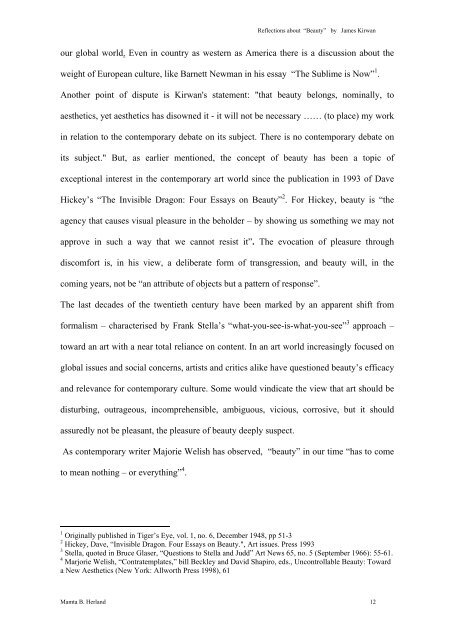Reflections about “Beauty” James Kirwan - Mamtaart.com - Mamta Art
Reflections about “Beauty” James Kirwan - Mamtaart.com - Mamta Art
Reflections about “Beauty” James Kirwan - Mamtaart.com - Mamta Art
You also want an ePaper? Increase the reach of your titles
YUMPU automatically turns print PDFs into web optimized ePapers that Google loves.
<strong>Reflections</strong> <strong>about</strong> <strong>“Beauty”</strong> by <strong>James</strong> <strong>Kirwan</strong><br />
our global world. Even in country as western as America there is a discussion <strong>about</strong> the<br />
weight of European culture, like Barnett Newman in his essay “The Sublime is Now” 1 .<br />
Another point of dispute is <strong>Kirwan</strong>'s statement: "that beauty belongs, nominally, to<br />
aesthetics, yet aesthetics has disowned it - it will not be necessary …… (to place) my work<br />
in relation to the contemporary debate on its subject. There is no contemporary debate on<br />
its subject." But, as earlier mentioned, the concept of beauty has been a topic of<br />
exceptional interest in the contemporary art world since the publication in 1993 of Dave<br />
Hickey’s “The Invisible Dragon: Four Essays on Beauty” 2 . For Hickey, beauty is “the<br />
agency that causes visual pleasure in the beholder – by showing us something we may not<br />
approve in such a way that we cannot resist it”. The evocation of pleasure through<br />
dis<strong>com</strong>fort is, in his view, a deliberate form of transgression, and beauty will, in the<br />
<strong>com</strong>ing years, not be “an attribute of objects but a pattern of response”.<br />
The last decades of the twentieth century have been marked by an apparent shift from<br />
formalism – characterised by Frank Stella’s “what-you-see-is-what-you-see” 3 approach –<br />
toward an art with a near total reliance on content. In an art world increasingly focused on<br />
global issues and social concerns, artists and critics alike have questioned beauty’s efficacy<br />
and relevance for contemporary culture. Some would vindicate the view that art should be<br />
disturbing, outrageous, in<strong>com</strong>prehensible, ambiguous, vicious, corrosive, but it should<br />
assuredly not be pleasant, the pleasure of beauty deeply suspect.<br />
As contemporary writer Majorie Welish has observed, “beauty” in our time “has to <strong>com</strong>e<br />
to mean nothing – or everything” 4 .<br />
1 Originally published in Tiger’s Eye, vol. 1, no. 6, December 1948, pp 51-3<br />
2 Hickey, Dave, “Invisible Dragon. Four Essays on Beauty.", <strong>Art</strong> issues. Press 1993<br />
3 Stella, quoted in Bruce Glaser, “Questions to Stella and Judd” <strong>Art</strong> News 65, no. 5 (September 1966): 55-61.<br />
4 Marjorie Welish, “Contratemplates,” bill Beckley and David Shapiro, eds., Uncontrollable Beauty: Toward<br />
a New Aesthetics (New York: Allworth Press 1998), 61<br />
<strong>Mamta</strong> B. Herland 12


